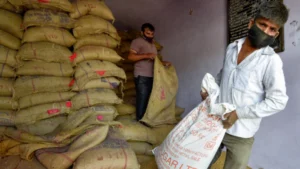GS II-POVERTY

Introduction
The National Food Security Act (NFSA), 2013, is a landmark social welfare legislation introduced by the Government of India. It aims to provide food security to the economically weaker sections of society by ensuring access to subsidized food grains. The Act covers 75% of the rural population and 50% of the urban population under two main categories:
- Antyodaya Anna Yojana (AAY) households
- Priority Households (PHH)
The allocation of beneficiaries under NFSA is based on data from the NSS Household Consumption Survey (2011-12).
Objectives of NFSA
- To ensure food security for all citizens by providing subsidized food grains.
- To improve the nutritional status of vulnerable populations.
- To reduce hunger and malnutrition by guaranteeing food supply to targeted beneficiaries.
- To provide a transparent and accountable food distribution system.
Key Features of NFSA
- Public Distribution System (PDS) under NFSA
- PDS coverage is not linked to poverty estimates but is based on Census 2011 population data.
- The Act covers two-thirds of India’s total population.
- State/UT-wise coverage is determined by NITI Aayog using the 2011-12 NSSO survey.
- The oldest woman in a beneficiary household is designated as the Head of the Family for ration card issuance.
- NFSA includes a grievance redressal mechanism through State Food Commissions, DGROs, and Vigilance Committees.
- Beneficiary Entitlements
| Category | Entitlement | Pricing (per kg) |
| Antyodaya Anna Yojana (AAY) | 35 kg of food grains per household per month | ₹3 (Rice), ₹2 (Wheat), ₹1 (Coarse grains) |
| Priority Households (PHH) | 5 kg per person per month | ₹3 (Rice), ₹2 (Wheat), ₹1 (Coarse grains) |
- Central Issue Prices (CIP) remain unchanged since 2019.
- No reduction in food grain allocation for any State/UT.
- Tide-Over allocation is provided to cover allocation gaps.
- Obligations Under NFSA
Central Government’s Role
- Allocation of food grains to States based on identified beneficiaries.
- Funding transportation, handling, and fair price shop (FPS) dealer margins.
- Ensuring transparency and accountability in food distribution.
State Governments’ Role
- Identifying eligible households and issuing NFSA ration cards.
- Ensuring smooth food grain distribution under PDS.
- Implementing maternal and child nutrition schemes.
- Establishing grievance redressal mechanisms at district and state levels.
Local Authorities’ Role
- Supervising fair price shops (FPS).
- Conducting social audits.
- Assisting in beneficiary identification.
- Addressing grievances related to food security.
State Ranking Index for NFSA 2022
General Category States
| State | Rank |
| Kerala | 1 |
| Tamil Nadu | 2 |
| Punjab | 3 |
| Gujarat | 4 |
| Maharashtra | 5 |
Special Category States
| State | Rank |
| Sikkim | 1 |
| Himachal Pradesh | 2 |
| Arunachal Pradesh | 3 |
| Uttarakhand | 4 |
| Assam | 5 |
Importance of Food Security
- Essential for Human Development: Ensures nutritious food access for all.
- Poverty Alleviation: Acts as a safety net for vulnerable populations.
- Prevention of Malnutrition: Helps reduce nutrient deficiencies.
- Social Stability: Minimizes conflicts arising due to food scarcity.
- Boosts Economic Productivity: Ensures a healthy, productive workforce.
Criticism of NFSA
- Implementation Challenges: Weak infrastructure, logistical issues, and corruption hamper effectiveness.
- Exclusion Errors: Genuine beneficiaries sometimes get left out due to flawed identification.
- Financial Burden: The procurement and distribution costs put pressure on the government.
- Limited Coverage: Some near-poverty households remain excluded from NFSA benefits.
Way Forward
- Strengthening Public Distribution System (PDS) for better targeting and delivery.
- Enhancing transparency and accountability in food distribution.
- Improving infrastructure for food storage and transportation.




